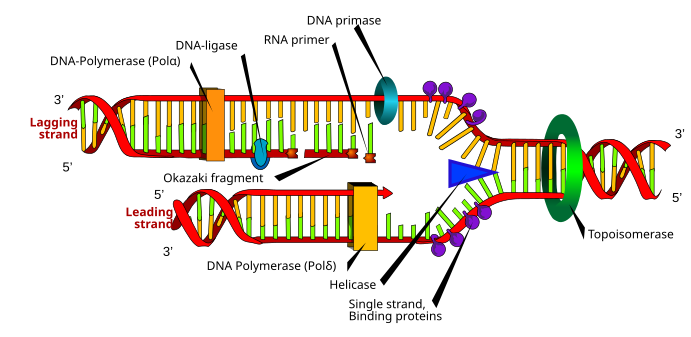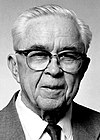Initiation:
The initiation point where the splitting starts is called "origin of replication". The structure that is created is known as "Replication Fork".
A helicase is the enzyme that splits the two strands. Thereafter, single-strand binding proteins (SSB) swiftly bind to the separated DNA, thus preventing the strands from reuniting. A primase, which generates an RNA primer to be used in DNA replication. RNA Primase can attract RNA nucleotides which bind to the DNA nucleotides of the 3'-5' strand due to the hydrogen bonds between the bases.
Elongation:
The elongation process is different for the 5'-3' and 3'-5' template. The leading strand is synthesized continuously in the 5'-3' direction by DNA polymeraseIII. The lagging strand is synthesized discontinuously Primase synthesizes a short RNA primer, which is extended by DNA polymeraseIII to form an Okazaki fragment.In the lagging strand the DNA Polymerase I reads the fragments and removes the RNA Primers. DNA Ligase joins in the Okazaki fragment to growing the strand.
Each new double helix is consisted of one old and one new chain. This is what we call semiconservative replication.
Termination:
The last step of DNA Replication is the Termination. This process happens when the DNA Polymerase reaches to an end of the strands. We can easily understand that in the last section of the lagging strand, when the RNA primer is removed, it is not possible for the DNA Polymerase to seal the gap (because there is no primer). So, the end of the parental strand where the last primer binds isn't replicated. These ends of linear (chromosomal) DNA consists of noncoding DNA that contains repeat sequences and are called telomeres. As a result, a part of the telomere is removed in every cycle of DNA Replication.
The DNA Replication is not completed before a mechanism of repair fixes possible errors caused during the replication. Enzymes like nucleases remove the wrong nucleotides and the DNA Polymerase fills the gaps.
Role of enzymes:
Role of enzymes:
The enzyme helicase seperates the DNA helix so the DNA can be replicated. The enzyme polymerase matches up the new nucleotide bases to the original bases (during replication) and the enzyme ligase "mends" or "glues" the phosphate "backbone" into place with the new nucleotide bases forming a replication of the original DNA strand. (Whichever strand was replicated at the time).




